Before planting seedlings in the ground, they are hardened off, creating conditions as close as possible to those in which they will grow. In this case, the seedlings quickly adapt to new conditions.
Disembarkation dates
The timing of planting tomatoes in the ground depends on weather conditions and the age of the seedlings.
Weather
Tomatoes are planted in the greenhouse when the daytime temperature is not lower than 7-8°C.In the middle zone and in the northwest after May 10, in the south - at the end of April. In case of severe cold weather or recurrent frosts, it is additionally covered with lutarsil or straw.
Plant in open ground only when the threat of frost has passed and the ground has warmed up to 14-16°C. In the northern regions this is the beginning or even mid-June, in the middle zone - the end of May-beginning of June. In the south, if the weather is warm enough, you can plant as early as mid-May. At low night temperatures, tomatoes are covered with a covering material (spunbond, lutarsil).
If the nights are very cold, then additionally cover the insulation with film. It is better not to cover with one film, since it does not allow air and moisture to pass through. In general, open-ground varieties tolerate cold nights and even prolonged cold snaps much better than greenhouse tomatoes, but they need air circulation. Therefore, spunbond is preferable to film.
Seedling age
In fact, this factor is not as important as the weather. Tomatoes, if temperature permits, can be planted after 2-3 true leaves appear. But in our country, due to climatic conditions, this is impossible even in the south. Therefore, the main thing is that the tomatoes do not overgrow.
Early varieties are planted after the first cluster of flowers appears. If the weather permits, you can do this earlier. But later it is impossible, because the plants outgrow, weaken, they become cramped in small cups, the roots entwine the earthen lump and become non-functional. By this time, it is advisable to transplant even cherry tomatoes into a large container (if they grow on the balcony). Typically, early tomatoes are planted between 50 and 60 days old.
The deadline for planting late varieties is the appearance of 7-8 true leaves.The standard recommendation is 70-80 days of age. It all depends on the weather and the region.
Hardening off seedlings before planting
If the seedlings grew on a windowsill and were not taken into the greenhouse, then they are hardened off before planting. This is especially necessary for open ground tomatoes.
2-3 weeks before planting, tomatoes are taken out onto the balcony or into the greenhouse, even on cold cloudy days (the temperature in the greenhouse should not be lower than 8-10°C, and the most optimal is 11-12°C). First, the plants are taken out for several hours, and after 3-4 days they can be left in a cool place all day.
At night, tomatoes are brought into the house, but the temperature is reduced to 12-14°C. If there is no greenhouse or balcony, the crop is sprayed daily with cold water in the morning and afternoon. And during the day, open a window or window to allow cool air to flow in.
Choosing a place for tomatoes
It is not advisable to grow tomatoes in one place for several years in a row.. When planted in a greenhouse, the best predecessors are cucumbers, since they have the least number of common diseases with tomatoes. Peppers and eggplants have many diseases in common with tomatoes.
In the greenhouse
Upon landing tomato seedlings After cucumbers, the soil is properly filled with fertilizers, since cucumbers take everything from it. In the fall, rotted manure or humus is added to the greenhouse, 4-5 buckets per m2. In the fall, you can add fresh manure 2-3 buckets per m2, since it will half decompose over the winter.
Tomatoes love rich, nutritious soil. By the way, in addition to fresh manure, of course, it causes rapid growth of the above-ground part, but also accelerates the ripening of fruits. In the middle zone, on soil well fertilized with manure, almost all the tomatoes that have set have time to turn red.But mineral nitrogen fertilizers do not give such an effect; they can accumulate in fruits in the form of nitrates. When fresh manure is added in the spring, all the plant’s energy goes into green mass, and it practically does not bloom.
Simultaneously with the manure, superphosphate is added to the greenhouse (2 tbsp/m2). If there are no fertilizers, you can add purchased soil for tomatoes and peppers. It is not recommended to use peat, as it strongly acidifies the soil, which tomatoes do not like.
Open ground
The place should be the sunniest; in the shade, tomatoes practically do not bear fruit or produce an insignificant amount of sour matter.
Excellent precursors for them are root vegetables and cabbage. They grow well after pumpkin crops. The soil is filled in the same way as for greenhouse tomatoes.
Planting seedlings in a greenhouse
In a greenhouse, tomatoes are planted either in one row or in a checkerboard pattern with a distance between plants of 70-80 cm. If planted sparsely, the yield is halved due to poor pollination. When thickened, air circulation is disrupted, and plants are quickly affected by diseases.
2-3 days before planting, cut off 1-2 lower leaves. This improves light and ventilation in the lower part of the stem, reduces the risk of disease and promotes better development of the first cluster.
The day before planting, water the plants generously to prevent severe damage to the roots. Well-watered plants are easily removed from the container along with a lump of earth.
Seedlings are planted after noon. Having chosen the planting method, make the holes somewhat deeper and wider than the pot with seedlings. The hole is filled to the brim with water and, when it is absorbed, water is added 2-3 more times.
The container with the plant is turned upside down and, lightly tapping the walls, it is removed along with a lump of earth. If the roots are wrapped around an earthen lump, they are removed, leaving developed roots growing vertically downwards. The roots that weave around the earthen ball are useless: after planting, they do not function and develop for a long time, which retards the growth of tomatoes.
Roots that are too long are pinched at 1/3 of the length.
There are several ways to plant seedlings.
1. In the holes
The culture along with a lump of earth is placed vertically in the hole and sprinkled with earth. The plants are buried a few centimeters and hilled (up to the first leaf, which must be cut). This stimulates the formation of adventitious roots and rapid growth of the crop.
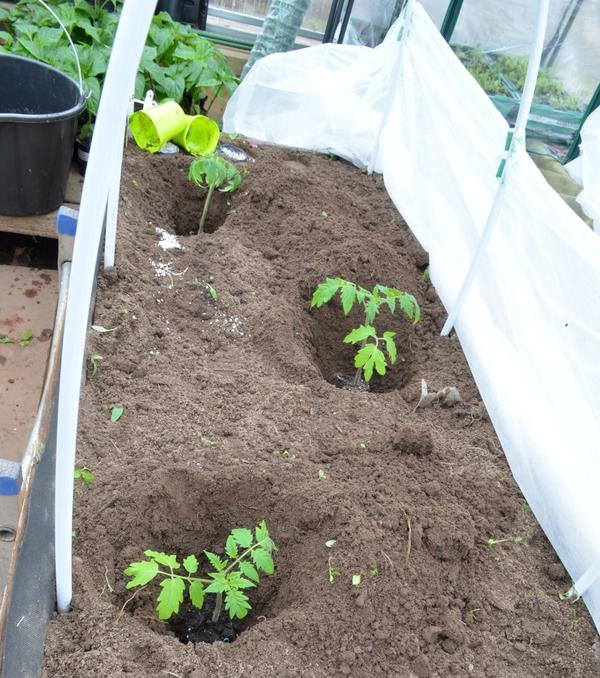
Not overgrown seedlings are planted standing in holes
2. Bent over
Used for slightly overgrown seedlings, as well as if the roots were severely damaged during transplantation. Tomatoes are capable of producing adventitious roots from any above-ground part when it comes into contact with moist soil. Planting in this way stimulates the formation of such roots in large quantities.
A small trench is dug and the tomatoes are placed in it at an angle of 45° or more. All lower leaves are torn off. The stem is covered with moist soil, leaving 4-5 true leaves on the surface.
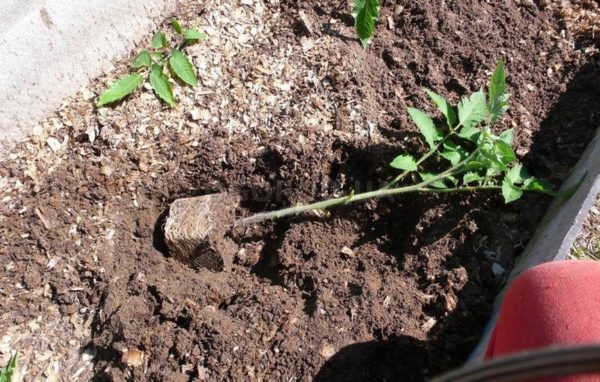
Elongated plants are planted lying down.
3. In a circle
This method is used for heavily overgrown seedlings. A hole is dug 15-20 cm deep, and seedlings with a lump of earth are placed horizontally in it. All lower leaves on the stem are torn off, leaving 3-4 upper leaves. The stem is laid in circles around a ball of earth and covered with damp soil.
Such seedlings give a smaller yield compared to normal ones.It also takes longer to develop and begins to bear fruit somewhat later. But in the end, the harvest is not much smaller; however, it ripens 2-3 weeks later, and in the middle zone and to the north this can lead to a shortage of fruit.
After planting, the tomatoes are watered abundantly and shaded.
Early planting of tomatoes in a greenhouse
Tomatoes can be planted very early (in the middle zone, late April-early May), if insulated bed.
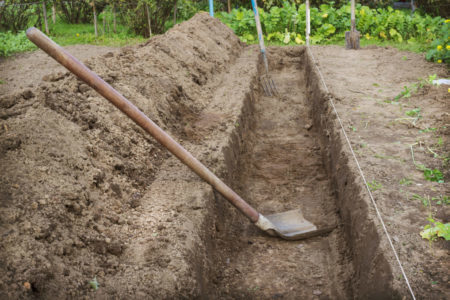
Warm bed.
In the spring, they dig a trench along the entire length of the bed with a depth of 1-1.5 shovels. They put hay, straw or dry leaves in it, cover it with earth on top, which is carefully compacted. It is impossible to introduce fresh manure into the trench, since the crop will increase green mass to the detriment of the harvest. You can add a bucket to m2 trenches of half-rotted manure. The soil is thoroughly poured with boiling water, and after 3-5 days the seedlings are planted.
Planting seedlings in open ground
The methods for planting tomatoes in open ground are the same as in a greenhouse. They are planted either in a checkerboard pattern or in rows. Since mainly determinate, low-growing varieties grow outside, the distance between plants is 40-50 cm, and between rows - 60-70 cm.
When growing super-determinate varieties, they are planted at a distance of 35 cm from each other and 40-45 cm between rows. Like greenhouse varieties, when planting, ground tomatoes are buried and hilled to form additional roots.
Tomatoes are planted in open ground when the temperature at night does not drop below 7-8°C. After planting, the tomatoes are watered generously, and then there is no watering for a week to allow the roots to grow deeper and wider in search of water.
Newly planted seedlings are covered with covering material, since, despite hardening, they are not immediately ready for a sharp change in growing conditions.
Caring for seedlings after planting in the greenhouse
Immediately after planting, water the tomatoes generously, and then watering is not carried out until the seedlings take root (a new sheet will appear).
Immediately after planting, the plants are tied to a horizontal trellis. It is better to make two: one 20 cm above the tops of the planted seedlings, and the second under the ceiling of the greenhouse. The stem of tomatoes should not be allowed to bend, as this interferes with the flow of substances from the roots to the above-ground parts. Immediately after planting, the seedlings are tied to the lower trellis, and when the tomatoes grow, they are tied to the upper one, and the lower one is removed.
After planting tomatoes in a greenhouse at low night temperatures, it is covered with covering material. When planting early, tomatoes must be covered, since even hardened seedlings have difficulty taking root in cold weather. During severe frosts, it is better to cover the crop with a double layer of thin material than with one layer of thick material. A double shelter retains heat better, and if it is planted in a warm bed, then under the shelter the seedlings can withstand night temperatures of -5 - -7°C.
If cold weather sets in after planting the seedlings, the tomatoes are additionally insulated with hay or straw. You can place hot bricks in the greenhouse overnight.
Planted tomatoes must be shaded for 3-5 days, otherwise they will burn under the bright spring sun. If they are protected from the cold, then additional shading is not required, since the covering material (except for film) shades the plants.
They start feeding after the tomatoes have taken root, as evidenced by the appearance of a new leaf.
Caring for seedlings in open ground
Tomatoes are planted in open ground when the threat of frost has passed. And yet the cold often returns, especially in the north and in the middle zone, where severe frosts can occur until June 10. Therefore, if there is a threat of frost, ground tomatoes are covered with spunbond.
If a very cold night is expected, then additionally cover with film. If the weather is cold, then the planted seedlings are ventilated for several hours a day during the warmest time, after which they are closed. The cover can be removed when it is at least 10°C at night. However, now there are good varieties that can easily tolerate temperatures of 5-7°C even at a young age.
The day before freezing, water the tomatoes well. Ground tomatoes tolerate night frosts well under cover. But if it’s cold during the day (no higher than 4°C), then the tomatoes are additionally covered with hay, dry leaves, straw or rags.
After planting the seedlings, they are tied to stakes so that the plant stems do not bend. Without a garter, ground tomatoes will lie down during heavy rains, and then it can be difficult to return them to a vertical position.
Like greenhouse seedlings, ground varieties provide shade the first few days after planting. Although they are more tolerant of the bright spring sun than greenhouse tomatoes, if they were kept on a windowsill in limited sunlight, they may suffer from burns. They appear more often on the lower leaves. Young leaves that appear after planting in the ground do not get burned.
After planting tomatoes, water them well. Further watering depends on the weather. In wet weather, do not water tomatoes at all. In dry weather, the next watering is carried out after 14-16 days.
In humid weather, newly rooted plants are loosened so that there is free access of air to the roots. When loosening tomatoes always hill up a little.
Planting seedlings is not such a difficult matter. Tomatoes are quite unpretentious (compared to cucumbers and peppers, for example) and mistakes made during planting can be easily corrected with further care.
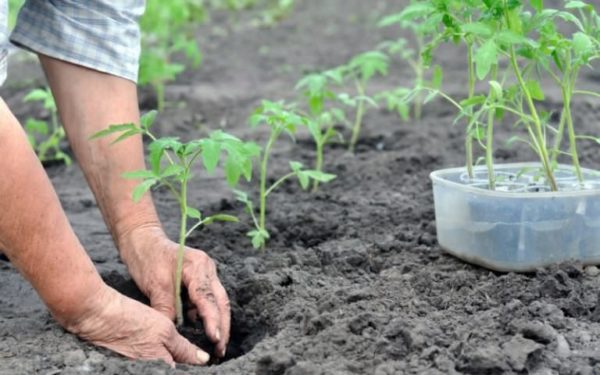
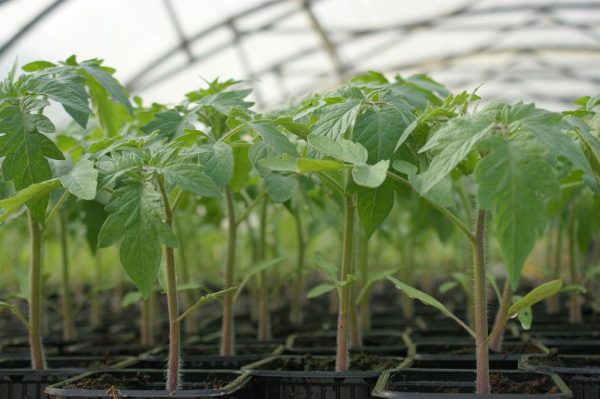
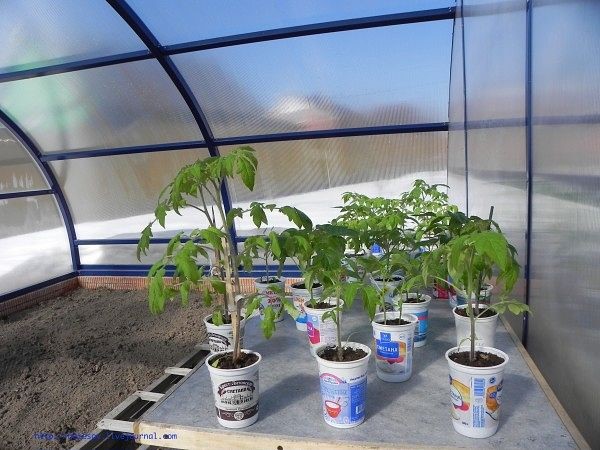
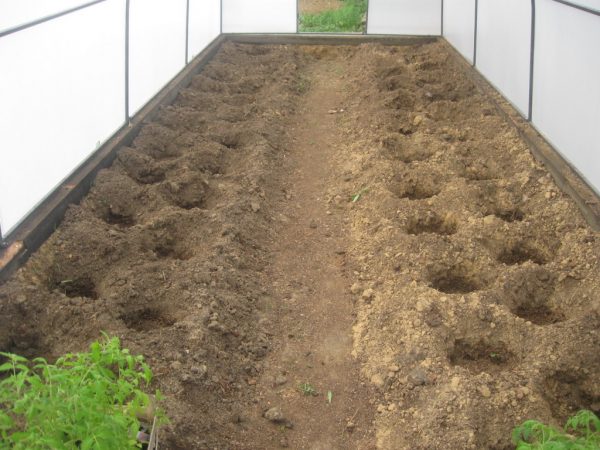
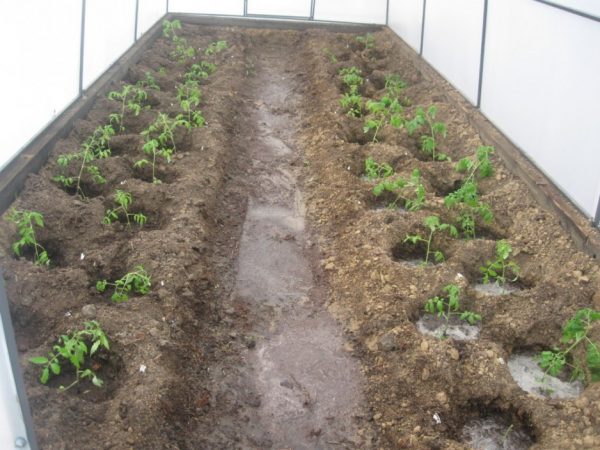
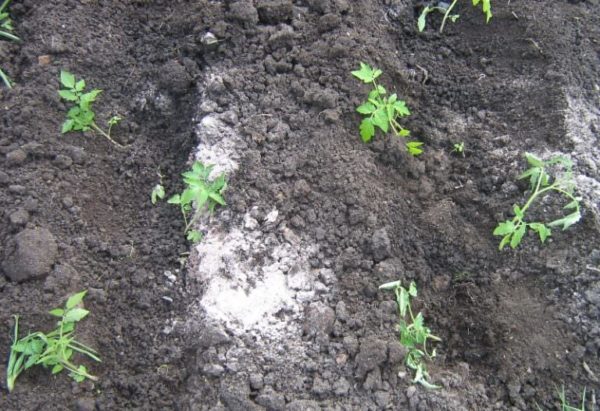
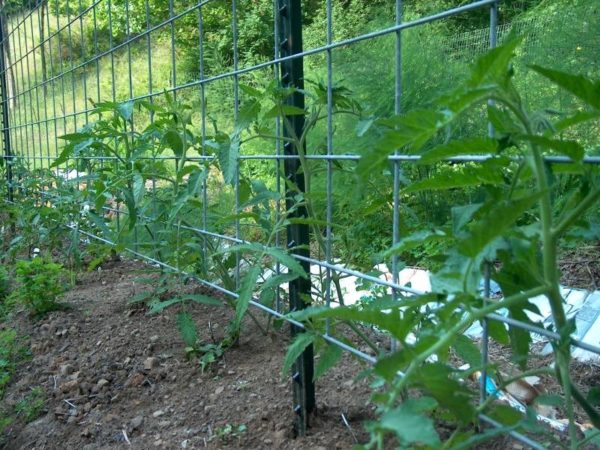

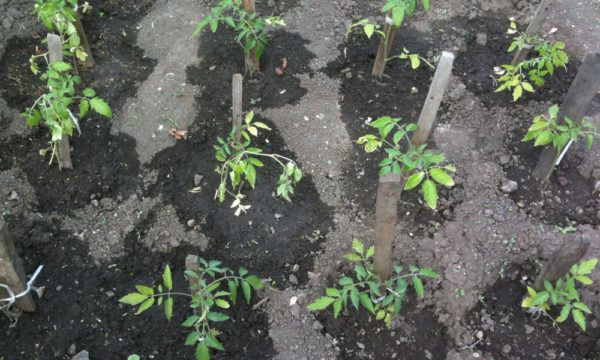

 (10 ratings, average: 4,20 out of 5)
(10 ratings, average: 4,20 out of 5) CUCUMBERS NEVER GET SICK, I'VE BEEN USING ONLY THIS FOR 40 YEARS! I SHARE A SECRET WITH YOU, CUCUMBERS ARE LIKE THE PICTURE!
CUCUMBERS NEVER GET SICK, I'VE BEEN USING ONLY THIS FOR 40 YEARS! I SHARE A SECRET WITH YOU, CUCUMBERS ARE LIKE THE PICTURE! You can dig a bucket of potatoes from each bush. Do you think these are fairy tales? Watch the video
You can dig a bucket of potatoes from each bush. Do you think these are fairy tales? Watch the video
 How our fellow gardeners work in Korea. There is a lot to learn and just fun to watch.
How our fellow gardeners work in Korea. There is a lot to learn and just fun to watch. Eye trainer. The author claims that with daily viewing, vision is restored. They don't charge money for views.
Eye trainer. The author claims that with daily viewing, vision is restored. They don't charge money for views. A 3-ingredient cake recipe in 30 minutes is better than Napoleon. Simple and very tasty.
A 3-ingredient cake recipe in 30 minutes is better than Napoleon. Simple and very tasty. Therapeutic exercises for cervical osteochondrosis. A complete set of exercises.
Therapeutic exercises for cervical osteochondrosis. A complete set of exercises. Which indoor plants match your zodiac sign?
Which indoor plants match your zodiac sign? What about them? Excursion to German dachas.
What about them? Excursion to German dachas.